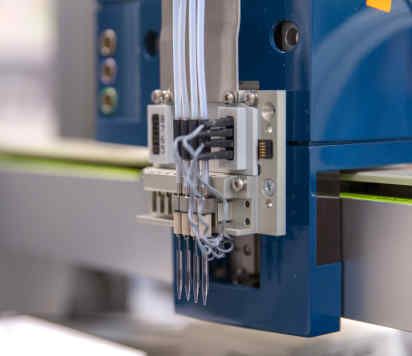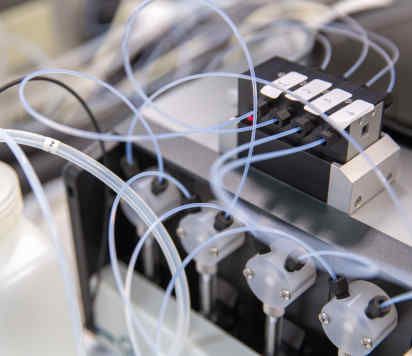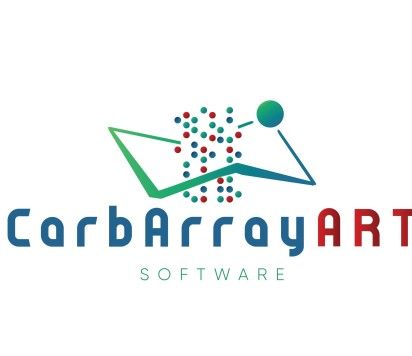Results
- Showing results for:
- Reset all filters
Search results
-
Journal articleChandra N, Liu Y, Liu J-X, et al., 2019,
Sulfated glycosaminoglycans as viral decoy receptors for human adenovirus type 37
, Viruses, Vol: 11, ISSN: 1999-4915Glycans on plasma membranes and in secretions play important roles in infection by many viruses. Species D human adenovirus type 37 (HAdV-D37) is a major cause of epidemic keratoconjunctivitis (EKC) and infects target cells by interacting with sialic acid (SA)-containing glycans via the fiber knob domain of the viral fiber protein. HAdV-D37 also interacts with sulfated glycosaminoglycans (GAGs), but the outcome of this interaction remains unknown. Here, we investigated the molecular requirements of HAdV-D37 fiber knob:GAG interactions using a GAG microarray and demonstrated that fiber knob interacts with a broad range of sulfated GAGs. These interactions were corroborated in cell-based assays and by surface plasmon resonance analysis. Removal of heparan sulfate (HS) and sulfate groups from human corneal epithelial (HCE) cells by heparinase III and sodium chlorate treatments, respectively, reduced HAdV-D37 binding to cells. Remarkably, removal of HS by heparinase III enhanced the virus infection. Our results suggest that interaction of HAdV-D37 with sulfated GAGs in secretions and on plasma membranes prevents/delays the virus binding to SA-containing receptors and inhibits subsequent infection. We also found abundant HS in the basement membrane of the human corneal epithelium, which may act as a barrier to sub-epithelial infection. Collectively, our findings provide novel insights into the role of GAGs as viral decoy receptors and highlight the therapeutic potential of GAGs and/or GAG-mimetics in HAdV-D37 infection.
-
Journal articleRudkin FM, Raziunaite I, Workman H, et al., 2019,
Single human B cell-derived monoclonal anti-<i>Candida</i> antibodies enhance phagocytosis and protect against disseminated candidiasis (vol 9, 5288, 2018)
, NATURE COMMUNICATIONS, Vol: 10, ISSN: 2041-1723 -
Journal articleRudkin FM, Raziunaite I, Workman H, et al., 2018,
Single human B cell-derived monoclonal anti-<i>Candida</i> antibodies enhance phagocytosis and protect against disseminated candidiasis
, NATURE COMMUNICATIONS, Vol: 9, ISSN: 2041-1723- Author Web Link
- Cite
- Citations: 43
-
Conference paperAkune Y, Arpinar S, Silva LM, et al., 2018,
CarbArrayART: Carbohydrate Array Analysis and Reporting Tool New software for glycan array for data processing, storage and presentation
, Annual Meeting of the Society-for-Glycobiology (SFG), Publisher: OXFORD UNIV PRESS INC, Pages: 1034-1035, ISSN: 0959-6658 -
Journal articleLi Z, Feizi T, 2018,
The neoglycolipid (NGL) technology-based microarrays and future prospects.
, FEBS Lett, Vol: 592, Pages: 3976-3991The neoglycolipid (NGL) technology is the basis of a state-of-the-art oligosaccharide microarray system, which we offer for screening analyses to the broad scientific community. We review here the sequential development of the technology and its power in pinpointing and isolating naturally occurring ligands for glycan-binding proteins (GBPs) within glycan populations. We highlight our Designer Array approach and Beam Search Array approach for generating natural glycome arrays to identify novel ligands of biological relevance. These two microarray approaches have been applied for assignments of ligands or antigens on glucan polysaccharides for effector proteins of the immune system (Dectin-1, DC-SIGN and DC-SIGNR) and carbohydrate-binding modules (CBMs) on bacterial hydrolases. We also discuss here the more recent applications to elucidate the structure of a prostate cancer- associated antigen F77 and identify ligands for adhesins of two rotaviruses, P[10] and P[19], expressed on an epithelial mucin glycoprotein.
-
Journal articleChai W, Zhang Y, Mauri L, et al., 2018,
Assignment by Negative-Ion Electrospray Tandem Mass Spectrometry of the Tetrasaccharide Backbones of Monosialylated Glycans Released from Bovine Brain Gangliosides
, JOURNAL OF THE AMERICAN SOCIETY FOR MASS SPECTROMETRY, Vol: 29, Pages: 1308-1318, ISSN: 1044-0305Gangliosides, as plasma membrane-associated sialylated glycolipids, are antigenic structures and they serve as ligands for adhesion proteins of pathogens, for toxins of bacteria, and for endogenous proteins of the host. The detectability by carbohydrate-binding proteins of glycan antigens and ligands on glycolipids can be influenced by the differing lipid moieties. To investigate glycan sequences of gangliosides as recognition structures, we have underway a program of work to develop a “gangliome” microarray consisting of isolated natural gangliosides and neoglycolipids (NGLs) derived from glycans released from them, and each linked to the same lipid molecule for arraying and comparative microarray binding analyses. Here, in the first phase of our studies, we describe a strategy for high-sensitivity assignment of the tetrasaccharide backbones and application to identification of eight of monosialylated glycans released from bovine brain gangliosides. This approach is based on negative-ion electrospray mass spectrometry with collision-induced dissociation (ESI-CID-MS/MS) of the desialylated glycans. Using this strategy, we have the data on backbone regions of four minor components among the monosialo-ganglioside-derived glycans; these are of the ganglio-, lacto-, and neolacto-series.
-
Conference paperStappers MHT, Clark AE, Aimanianda V, et al., 2018,
Recognition of DHN-melanin by the C-type lectin, MelLec, is required for protective immunity to Aspergillus fumigatus
, Publisher: OXFORD UNIV PRESS, Pages: S156-S156, ISSN: 1369-3786 -
Journal articleLenman A, Liaci AM, Liu Y, et al., 2018,
Polysialic acid is a cellular receptor for human adenovirus 52
, Proceedings of the National Academy of Sciences of the United States of America, Vol: 115, Pages: E4264-E4273, ISSN: 0027-8424Human adenovirus 52 (HAdV-52) is one of only three known HAdVs equipped with both a long and a short fiber protein. While the long fiber binds to the coxsackie and adenovirus receptor, the function of the short fiber in the virus life cycle is poorly understood. Here, we show, by glycan microarray analysis and cellular studies, that the short fiber knob (SFK) of HAdV-52 recognizes long chains of α-2,8-linked polysialic acid (polySia), a large posttranslational modification of selected carrier proteins, and that HAdV-52 can use polySia as a receptor on target cells. X-ray crystallography, NMR, molecular dynamics simulation, and structure-guided mutagenesis of the SFK reveal that the nonreducing, terminal sialic acid of polySia engages the protein with direct contacts, and that specificity for polySia is achieved through subtle, transient electrostatic interactions with additional sialic acid residues. In this study, we present a previously unrecognized role for polySia as a cellular receptor for a human viral pathogen. Our detailed analysis of the determinants of specificity for this interaction has general implications for protein–carbohydrate interactions, particularly concerning highly charged glycan structures, and provides interesting dimensions on the biology and evolution of members of Human mastadenovirus G.
-
Journal articleStappers MHT, Clark AE, Aimanianda V, et al., 2018,
Recognition of DHN-melanin by a C-type lectin receptor is required for immunity to Aspergillus
, NATURE, Vol: 555, Pages: 382-386, ISSN: 0028-0836Resistance to infection is critically dependent on the ability of pattern recognition receptors to recognize microbial invasion and induce protective immune responses. One such family of receptors are the C-type lectins, which are central to antifungal immunity1. These receptors activate key effector mechanisms upon recognition of conserved fungal cell-wall carbohydrates. However, several other immunologically active fungal ligands have been described; these include melanin2,3, for which the mechanism of recognition is hitherto undefined. Here we identify a C-type lectin receptor, melanin-sensing C-type lectin receptor (MelLec), that has an essential role in antifungal immunity through recognition of the naphthalene-diol unit of 1,8-dihydroxynaphthalene (DHN)-melanin. MelLec recognizes melanin in conidial spores of Aspergillus fumigatus as well as in other DHN-melanized fungi. MelLec is ubiquitously expressed by CD31+ endothelial cells in mice, and is also expressed by a sub-population of these cells that co-express epithelial cell adhesion molecule and are detected only in the lung and the liver. In mouse models, MelLec was required for protection against disseminated infection with A. fumigatus. In humans, MelLec is also expressed by myeloid cells, and we identified a single nucleotide polymorphism of this receptor that negatively affected myeloid inflammatory responses and significantly increased the susceptibility of stem-cell transplant recipients to disseminated Aspergillus infections. MelLec therefore recognizes an immunologically active component commonly found on fungi and has an essential role in protective antifungal immunity in both mice and humans.
-
Book chapterLiu Y, Palma AS, Ten F, et al., 2018,
Insights Into Glucan Polysaccharide Recognition Using Glucooligosaccharide Microarrays With Oxime-Linked Neoglycolipid Probes
, CHEMICAL GLYCOBIOLOGY, PT B: MONITORING GLYCANS AND THEIR INTERACTIONS, Editors: Imperiali, Publisher: ELSEVIER ACADEMIC PRESS INC, Pages: 139-167- Author Web Link
- Cite
- Citations: 6
This data is extracted from the Web of Science and reproduced under a licence from Thomson Reuters. You may not copy or re-distribute this data in whole or in part without the written consent of the Science business of Thomson Reuters.
General enquiries
Carbohydrate microarray analyses
Professor Ten Feizi
t.feizi@imperial.ac.uk
+44 (0) 20 7594 7207
Dr Yan Liu
yan.liu2@imperial.ac.uk
+44 (0) 20 7594 2598
Dr Antonio Di Maio
a.di-maio@imperial.ac.uk
Carbohydrate structural analyses
Dr Wengang Chai
w.chai@imperial.ac.uk
+44 (0) 20 7594 2596





